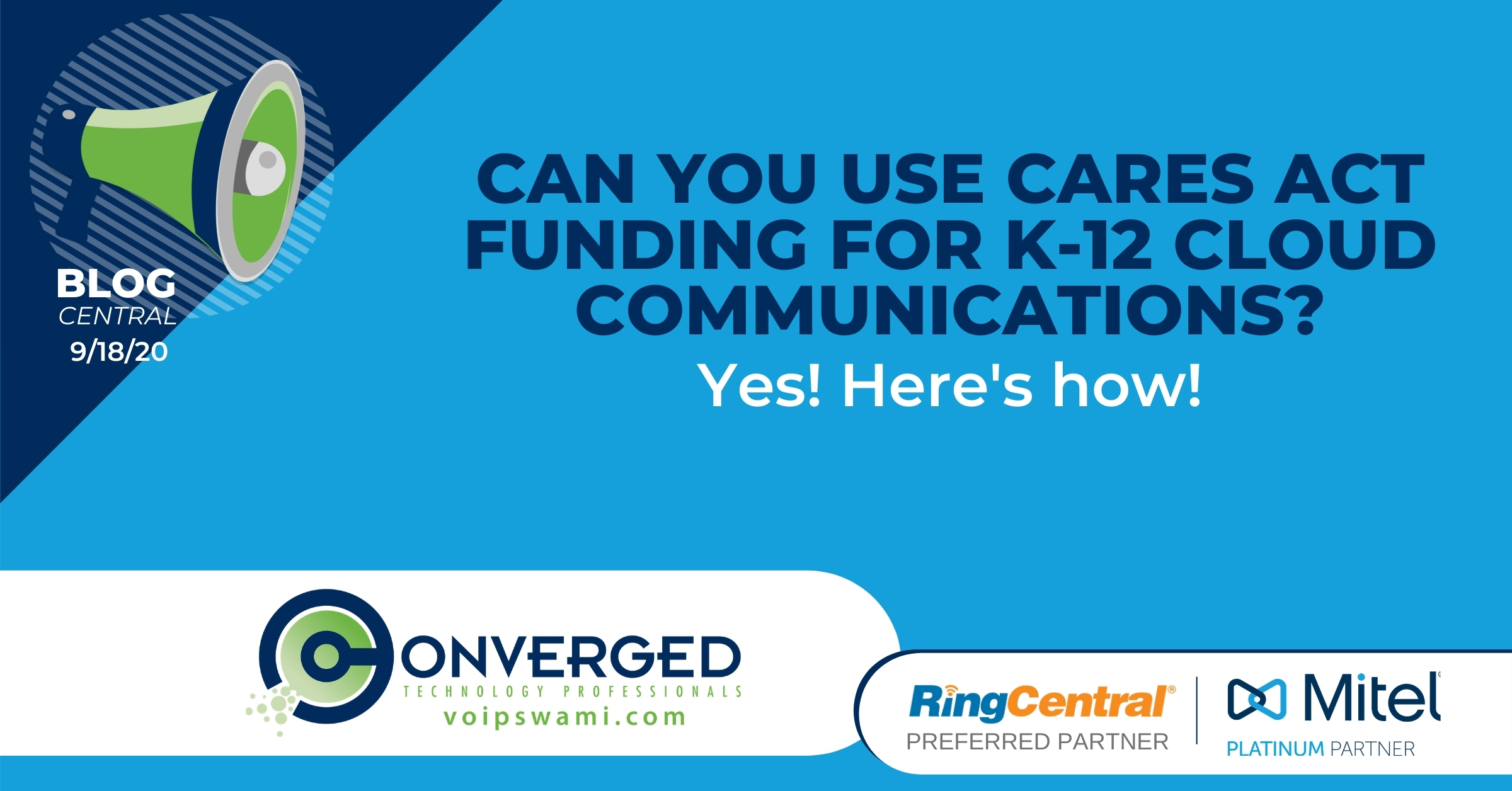
As part of the application process for acquiring CARES Act funding for K-12, applicants must indicate how they plan on using the funds. Fortunately, the guidelines are fairly generic and not too specific as one would typically experience when applying for grant money. The goal was for the Federal government to make funds available as quickly as possible while preventing improper use of the funds.
The list of allowable uses as defined by the US Department of Education, opens the door for school districts to purchase technologies that otherwise would not have been made possible through their normal annual budgets.
Keep in mind, although deadlines for applying have almost arrived, or maybe already passed (depending when you read this), the current deadline for using approved funds are set for September 2022. So, although you may not know exactly what technologies or vendors you will use, or how they’ll be deployed, you will have time to sort those details out.
Keep that in mind too that you’ll want to factor in enlisting the role of a consulting or vendor support partner experienced in these technologies (such as ourselves) that will help you navigate the ins and outs during the entire process.
In this post, we’ll be focusing on the specific categories in the allowable list that reference technology and how schools and local governments can develop a strategic plan for how to use those funds to implement systems and solutions that maintain communication continuity when events such as pandemics or other emergencies occur.
It should be stated upfront that we are currently waiting for Congress to agree on a 2nd stimulus bill for the CARES Act. We will provide an update here when we learn more. It is unknown if these listed allowable uses will be the same, or will have changed, and to what degree.
Looking for New CARES Act Funding for K-12? Already Have Funding? No Funding? No Problem.
There are a few scenarios you may fit into when researching cloud communication solutions that will improve a school's ability to properly support a distance learning, remote learning, online learning, or some combination of all the above.
You either:
- Already have funding made available by the first CARES Act Education Stabilization and Fund Program
- Waiting to receive the funding made available by the first CARES Act (you applied, but not received funds yet)
- Looking to apply for additional funding when and if the 2nd CARES Act is available (HEROES Act)
- You do not have grant funding at all, but want to research cloud based unified communication solutions to submit in your annual budget regardless
Regardless of which category you fit into, the ability to use technology to implement a new or updated communications infrastructure that enables teachers, faculty, administrative staff, students and parents to remain securely connected is still a critically relevant challenge to address.
Which CARES Act Allowable Use Cases for K-12 Relief Apply to Technology?
Out of the 13 listed allowable uses, some are rather generic and open to interpretation.
For example, #3 states:
Providing school leaders with the resources necessary to address the needs of their individual schools.
What constitutes “resources necessary”? Obviously, a cloud based solution that is able to address the needs of district-wide communications such as receiving and making phone calls, holding conference bridge meetings and sharing files and documents are deemed necessary.
Cloud communication platforms for k-12 education make this possible and can easily be considered as a necessary resource.
Here's another allowable use case that references technology in the following way:
Planning for and coordinating during long-term closures, including for how to provide meals to eligible students, how to provide technology for online learning to all students, and how to ensure other educational services can continue to be provided consistent with all Federal, State, and local requirements.
This use specifically talks about technology for online learning. In order to support online learning and ensure services can continue, schools need a reliable and flexible solution/platform that enables proper communication between all parties, and one that provides collaboration between the various stakeholders as well.
Using a cloud unified communications platform vs. a variety of disparate and unconnected tools and applications is what schools need to make sure their ability to communicate isn’t hampered during long-term closures, and yet still satisfies government requirements.
Moving on down the list is another allowable use:
Purchasing educational technology (including hardware, software, and connectivity) for students that aids in regular and substantive educational interaction between students and their classroom instructors, including low-income students and students with disabilities, to include assistive technology or adaptive equipment
Most school districts use legacy on-prem pbx systems that provide the connectivity needed between teachers, students, or other parties. Many of these systems are limited and weren't designed to accommodate remote users at scale. This has led to inefficient communications in an online, distant, or remote learning environment, where learning-loss is a serious concern.
With a cloud solution that addresses these challenges, all parties can communicate via phone, video, SMS, and chat through a secure platform which only requires an internet connection, regardless of device. Funds are available for purchasing laptops for low income students so they can participate in this virtual environment.
Last but not least, is another allowable use that also applies:
Other activities that are necessary to maintain the operation of and continuity of services in local educational agencies and continuing to employ existing LEA staff
Students and teachers aren’t the only ones needing a communications platform to communicate virtually. Local school district staff perform critical tasks such as curriculum planning and writing, transportation and meal planning, receptionist and secretarial duties such as answering parent calls, scheduling and coordinating meetings, among other important responsibilities that are equally as important.
All of these functions are critical for maintaining the continuity of services the school system provides to keep services running.
Preparing for the Future with Cloud Communications for Education K-12
School district officials, IT directors, and other decision-making parties, must understand that cloud based unified communications and collaboration solutions, such as RingCentral, are not a product of the pandemic. However, it is in these times that schools have been put into a position that they now are realizing the extremely valuable role these communication platforms and tools have in maintaining continuity throughout the school district ecosystem, and the many benefits they offer both in the immediate and long-term.
Benefits such as:
- Retaining the ability to communicate among internal district users as well as with external participants even in a partially in-person learning environment
- Consolidation of multiple collaboration tools for school district employees through a single interface and platform including video, SMS, chat, fax, voice, voicemail, voicemail to text, meetings, and webinars
- Easy accessibility for students, teachers and other users through desktop apps, web browsers or mobile applications
- Budget friendly technology purchases with fewer hard costs due to internal on-premise vendor license renewals and purchases
- Easy remote user configuration and set up for at-home or off-site users
- Use of softphones installed on computers or mobile devices reduce the need for purchasing and wiring costly hard desk phones. Headsets qualify for grant funding to help users limit background noise during learning or meeting sessions.
- Greater scalability within the system as new staff and employees are added
- Increased privacy and security protection between internal and external parties such as teacher and parent or student communications, meeting teacher union requirements
- Can be used in conjunction with existing pbx systems through call forwarding and other options. Make sure to work with your communications partner that is experienced with the manufacturer to confirm compatibility.

Maintaining Continuity with Cloud Communications Technology
As you can see, the CARES Act Funding grants for K-12 is making it possible for school districts to maintain operations and responsiveness to emergencies of many kinds, even though the pandemic is the initial force behind this surge in cloud communications for education, it is fair to say schools are opening up to the option much sooner than they anticipated.
There is a lot more to cover which cannot all be outlined here in this post. We therefore encourage you to reach out and let us know how we can help you facilitate this change, including free grant funding assistance and guidance throughout the process.
As a RingCentral Premier Partner we specialize in the consultation and deployment of cloud communication and collaboration solutions for those in education. We support a number of schools and school districts, including the 7th largest school district in the nation.
Contact us online or call us at 888-338-0532 and we will be glad to show you how a platform like RingCentral can be used within your school or school district to overcome the many challenges you are currently dealing with.
